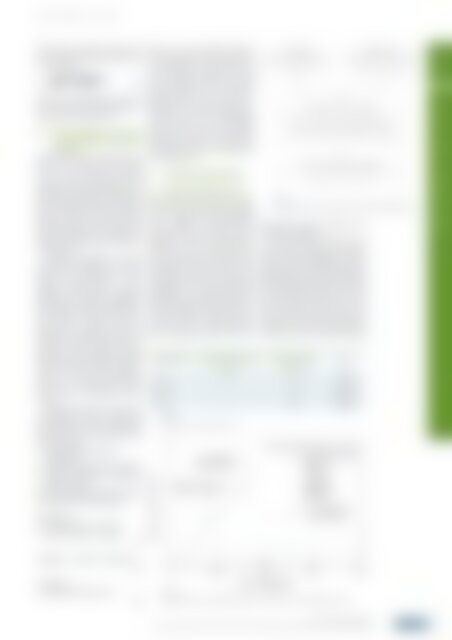atw - International Journal for Nuclear Power | 05.2020
Description Ever since its first issue in 1956, the atw – International Journal for Nuclear Power has been a publisher of specialist articles, background reports, interviews and news about developments and trends from all important sectors of nuclear energy, nuclear technology and the energy industry. Internationally current and competent, the professional journal atw is a valuable source of information. www.nucmag.com
Description
Ever since its first issue in 1956, the atw – International Journal for Nuclear Power has been a publisher of specialist articles, background reports, interviews and news about developments and trends from all important sectors of nuclear energy, nuclear technology and the energy industry. Internationally current and competent, the professional journal atw is a valuable source of information.
www.nucmag.com
Create successful ePaper yourself
Turn your PDF publications into a flip-book with our unique Google optimized e-Paper software.
<strong>atw</strong> Vol. 65 (2020) | Issue 5 ı May<br />
The average surface-to-volume ratio<br />
of various types of debris constituents<br />
is calculated as:<br />
(6)<br />
where v is the microscopic volume of<br />
the constituent and the subscript “n”<br />
refers to the n-th constituent.<br />
2.2 WCAP-16530 post-accident<br />
chemical effects evaluation<br />
method<br />
The materials inside containment may<br />
dissolve or corrode when exposed<br />
to the reactor coolant and spray<br />
solutions. This would produce oxide<br />
particulate corrosion products and a<br />
potential <strong>for</strong> <strong>for</strong>mation of precipitates<br />
due to chemical reactions with other<br />
dissolved materials. These chemical<br />
products may become another source<br />
of debris loading to be considered in<br />
sump screen per<strong>for</strong>mance and downstream<br />
effects.<br />
Recently Westinghouse Owners<br />
Group (WOG) proposed a four step<br />
process <strong>for</strong> evaluating the postaccident<br />
chemical effects in containment<br />
sump fluids to support<br />
GSI-191 [6]. As shown in Figure 1,<br />
using ICET test results and plant data,<br />
the chemistry bench tests are per<strong>for</strong>med<br />
and a chemical model is<br />
developed to identify the type and<br />
amount of chemical products that are<br />
produced. This chemical product<br />
in<strong>for</strong>mation generated from the bench<br />
testing and the chemical model is<br />
used as an input to per<strong>for</strong>mance<br />
testing to be conducted by licenses<br />
and vendors of replacement sump<br />
screens.<br />
Through bench test, three types of<br />
predominant chemical precipitates<br />
are identified <strong>for</strong> the plant using<br />
NaOH or TSP (Tri-Sodium Phosphate)<br />
as a buffer agent:<br />
p Sodium aluminum silicate<br />
(NaAlSi 3 O 8 )<br />
p Aluminum oxyhydroxide (AlOOH)<br />
p Calcium phosphate (Ca 3 (PO 4 ) 2 )<br />
(if TSP is used)<br />
Each quantity of precipitate generated<br />
can be calculated as followings:<br />
where <strong>for</strong> each chemical species,<br />
concentration data generated during<br />
the single-effect bench testing at<br />
specific chemistry conditions is used<br />
in a regression analysis to develop<br />
release equations as a function of<br />
temperature, pH, and the concentration<br />
of that species. Equations are<br />
developed <strong>for</strong> each predominant<br />
source material <strong>for</strong> each chemical<br />
species (Ca, Al, and Si). The detailed<br />
in<strong>for</strong>mation about the equations <strong>for</strong><br />
the material release rate is described<br />
in the reference 6.<br />
3 Results and discussion<br />
3.1 Effects of debris sources<br />
The sump screen head loss calculations<br />
with various debris loadings<br />
on the sump screen are per<strong>for</strong>med<br />
using USNRC’s NUREG/CR-6224<br />
correlation [5]. The screen area is<br />
assumed as 1,000 ft 2 with maximum<br />
ECCS flow rate of 7,000 gpm. The<br />
sump pool temperature and pressure<br />
are assumed as 212 °F and 14.7 psi,<br />
respectively. The debris source and<br />
their characteristics are summarized<br />
in Table 1. It is assumed that the<br />
particulate debris mixture consists of<br />
85 % of coatings, 10 % CalSil and 5 %<br />
of latent dust/dirt debris by mass.<br />
The head loss by RMI (Reflective<br />
Metal Insulation) debris bed is not<br />
Debris Type<br />
As-fabricated Density<br />
[lbm/ft 3 ]<br />
| Tab. 1.<br />
Debris source and characteristics [3,4].<br />
| Fig. 1.<br />
WCAP-16350 Post-Accident Chemical Effects Evaluation Methodology.<br />
con sidered because its effect on the<br />
head loss is negligible<br />
The head loss with various loadings<br />
of fiber and particulate mixture<br />
debris is shown in Figure 2. The head<br />
losses by fiber only debris beds are<br />
significantly lower than mixed debris<br />
beds of fiber and particulate. The head<br />
loss appreciably increases with the<br />
amount of particulate debris. Head<br />
loss drastically increases with the<br />
decrease of the amount of fiber debris<br />
because the mass ratio of particulate<br />
to fiber increases. The debris packing<br />
Particle Density<br />
[lbm/ft 3 ]<br />
Sv<br />
[ft -1 ]<br />
Fiber 2.4 175 171,700<br />
Coatings - 94 183,000<br />
CalSil - 115 600,000<br />
Dirt/Dust - 169 106,000<br />
ENVIRONMENT AND SAFETY 277<br />
[NaAlSi 3 O 8 ]<br />
= 3.11 [Si], if [Si] < 3.12 [Al]<br />
= 9.72 [Al], if [Si] > 3.12 [Al]<br />
(7)<br />
[AlOOH] = 2.22 {[Al] - 0.32 [Si]}<br />
(8)<br />
[Ca 3 (PO 4 ) 2 ]<br />
= 2.58 [Ca] (if TSP is used)<br />
(9)<br />
| Fig. 2.<br />
Head loss with various mixed debris loading on the 1,000 ft 2 sump screen (7000 gpm ECCS flow).<br />
Environment and Safety<br />
Physical and Chemical Effects of Containment Debris on the Emergency Coolant Recirculation ı Jisu Kim and Jong Woon Park

















